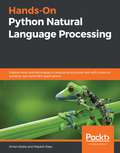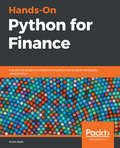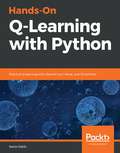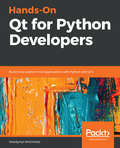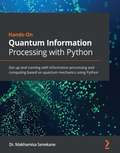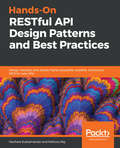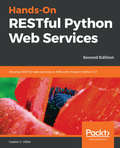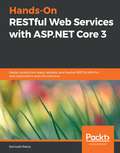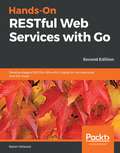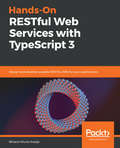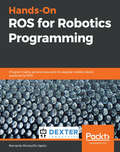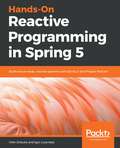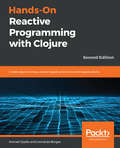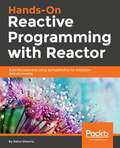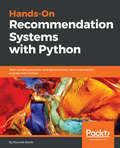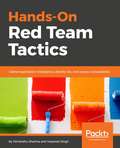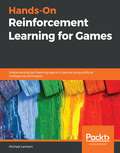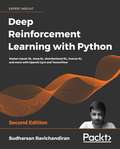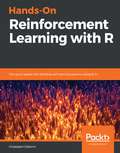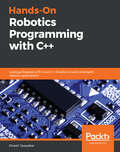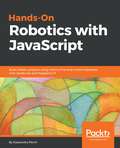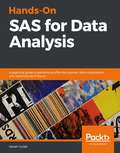- Table View
- List View
Hands-On Python Natural Language Processing: Explore tools and techniques to analyze and process text with a view to building real-world NLP applications
by Aman Kedia Mayank RasuGet well-versed with traditional as well as modern natural language processing concepts and techniques Key Features Perform various NLP tasks to build linguistic applications using Python libraries Understand, analyze, and generate text to provide accurate results Interpret human language using various NLP concepts, methodologies, and tools Book Description Natural Language Processing (NLP) is the subfield in computational linguistics that enables computers to understand, process, and analyze text. This book caters to the unmet demand for hands-on training of NLP concepts and provides exposure to real-world applications along with a solid theoretical grounding. This book starts by introducing you to the field of NLP and its applications, along with the modern Python libraries that you'll use to build your NLP-powered apps. With the help of practical examples, you'll learn how to build reasonably sophisticated NLP applications, and cover various methodologies and challenges in deploying NLP applications in the real world. You'll cover key NLP tasks such as text classification, semantic embedding, sentiment analysis, machine translation, and developing a chatbot using machine learning and deep learning techniques. The book will also help you discover how machine learning techniques play a vital role in making your linguistic apps smart. Every chapter is accompanied by examples of real-world applications to help you build impressive NLP applications of your own. By the end of this NLP book, you'll be able to work with language data, use machine learning to identify patterns in text, and get acquainted with the advancements in NLP. What you will learn Understand how NLP powers modern applications Explore key NLP techniques to build your natural language vocabulary Transform text data into mathematical data structures and learn how to improve text mining models Discover how various neural network architectures work with natural language data Get the hang of building sophisticated text processing models using machine learning and deep learning Check out state-of-the-art architectures that have revolutionized research in the NLP domain Who this book is for This NLP Python book is for anyone looking to learn NLP's theoretical and practical aspects alike. It starts with the basics and gradually covers advanced concepts to make it easy to follow for readers with varying levels of NLP proficiency. This comprehensive guide will help you develop a thorough understanding of the NLP methodologies for building linguistic applications; however, working knowledge of Python programming language and high school level mathematics is expected.
Hands-On Python for Finance: A practical guide to implementing financial analysis strategies using Python
by Krish NaikLearn and implement quantitative finance using popular Python libraries like NumPy, pandas, and Keras Key Features Understand Python data structure fundamentals and work with time series data Use popular Python libraries including TensorFlow, Keras, and SciPy to deploy key concepts in quantitative finance Explore various Python programs and learn finance paradigms Book Description Python is one of the most popular languages used for quantitative finance. With this book, you'll explore the key characteristics of Python for finance, solve problems in finance, and understand risk management. The book starts with major concepts and techniques related to quantitative finance, and an introduction to some key Python libraries. Next, you'll implement time series analysis using pandas and DataFrames. The following chapters will help you gain an understanding of how to measure the diversifiable and non-diversifiable security risk of a portfolio and optimize your portfolio by implementing Markowitz Portfolio Optimization. Sections on regression analysis methodology will help you to value assets and understand the relationship between commodity prices and business stocks. In addition to this, you'll be able to forecast stock prices using Monte Carlo simulation. The book will also highlight forecast models that will show you how to determine the price of a call option by analyzing price variation. You'll also use deep learning for financial data analysis and forecasting. In the concluding chapters, you will create neural networks with TensorFlow and Keras for forecasting and prediction. By the end of this book, you will be equipped with the skills you need to perform different financial analysis tasks using Python What you will learn Clean financial data with data preprocessing Visualize financial data using histograms, color plots, and graphs Perform time series analysis with pandas for forecasting Estimate covariance and the correlation between securities and stocks Optimize your portfolio to understand risks when there is a possibility of higher returns Calculate expected returns of a stock to measure the performance of a portfolio manager Create a prediction model using recurrent neural networks (RNN) with Keras and TensorFlow Who this book is for This book is ideal for aspiring data scientists, Python developers and anyone who wants to start performing quantitative finance using Python. You can also make this beginner-level guide your first choice if you're looking to pursue a career as a financial analyst or a data analyst. Working knowledge of Python programming language is necessary.
Hands-On Q-Learning with Python: Practical Q-learning with OpenAI Gym, Keras, and TensorFlow
by Nazia HabibLeverage the power of reward-based training for your deep learning models with Python Key Features Understand Q-learning algorithms to train neural networks using Markov Decision Process (MDP) Study practical deep reinforcement learning using Q-Networks Explore state-based unsupervised learning for machine learning models Book Description Q-learning is a machine learning algorithm used to solve optimization problems in artificial intelligence (AI). It is one of the most popular fields of study among AI researchers. This book starts off by introducing you to reinforcement learning and Q-learning, in addition to helping you get familiar with OpenAI Gym as well as libraries such as Keras and TensorFlow. A few chapters into the book, you will gain insights into modelfree Q-learning and use deep Q-networks and double deep Q-networks to solve complex problems. This book will guide you in exploring use cases such as self-driving vehicles and OpenAI Gym's CartPole problem. You will also learn how to tune and optimize Q-networks and their hyperparameters. As you progress, you will understand the reinforcement learning approach to solving real-world problems. You will also explore how to use Q-learning and related algorithms in real-world applications such as scientific research. Toward the end, you'll gain a sense of what's in store for reinforcement learning. By the end of this book, you will be equipped with the skills you need to solve reinforcement learning problems using Q-learning algorithms with OpenAI Gym, Keras, and TensorFlow. What you will learn Explore the fundamentals of reinforcement learning and the state-action-reward process Understand Markov decision processes Get well versed with libraries such as Keras, and TensorFlow Create and deploy model-free learning and deep Q-learning agents with TensorFlow, Keras, and OpenAI Gym Choose and optimize a Q-Network's learning parameters and fine-tune its performance Discover real-world applications and use cases of Q-learning Who this book is for If you are a machine learning developer, engineer, or professional who wants to delve into the deep learning approach for a complex environment, then this is the book for you. Proficiency in Python programming and basic understanding of decision-making in reinforcement learning is assumed.
Hands-On Qt for Python Developers: Build cross-platform GUI applications with Python and Qt 5
by Volodymyr KirichinetsBoost UI development with ready-made widgets, controls, charts, and data visualization and create stunning 2D and 3D graphics with PyQt and PySide2.Key FeaturesBuild optimized GUI applications by implementing multiprocessing and concurrencyUnderstand embedded and mobile development with PyQt and PySideLearn to create magnificent GUI applications using Pyside2 and QtQuick/QMLBook DescriptionQt is one of the most widely used and flexible frameworks for GUI application development, allowing you to write your application once and then deploy it to multiple operating systems. This book combines the best of Python and Qt to help you develop GUI applications with Python bindings, such as PyQt and PySide, that will supercharge your Python applications.The book begins with an overview of Qt and QML. You’ll start by working with PyQt GUI elements to style your applications. Then, you will learn how to use QWidget, frames, labels, and text fields, and work with graphics. This will be followed by taking you through how elements in the application communicate with each other by understanding signals, slots, and event handlers. This book will help you to gain a better understanding of the Qt framework and the tools to resolve issues when testing, linking, debugging, and multithreading your Python GUI applications. Finally, the book will help you get to grips with embedded and mobile development using PyQt and PySide.By the end of the book, you will be able to create modern, responsive, cross-platform desktop applications with the power of Qt, Python, and QML.What you will learnExplore PyQt5 and PySide2 to create comprehensive GUI applicationsFind out how threading and multiprocessing workUnderstand how to style GUIs with PyQtGet to grips with implementing buttonsUnderstand how elements communicate with signals, slots, and event handlersExplore mobile development with PyQt and PySideWho this book is forThis book is for Python developers who want to develop GUIs and cross-platform applications that are modern, responsive, and attractive. No prior knowledge of Qt or QML is required.
Hands-On Quantum Information Processing with Python: Get up and running with information processing and computing based on quantum mechanics using Python
by Dr. Makhamisa SenekaneExplore the potential of quantum information processing and understand the state of a quantum system with this practical guideKey FeaturesGet well-versed with quantum information processing using PythonUnderstand the basics of quantum cryptography by implementing quantum key distribution protocols in PythonImplement well-known games such as the CHSH and GHZ games using quantum strategies and techniquesBook DescriptionQuantum computation is the study of a subclass of computers that exploits the laws of quantum mechanics to perform certain operations that are thought to be difficult to perform on a non-quantum computer. Hands-On Quantum Information Processing with Python begins by taking you through the essentials of quantum information processing to help you explore its potential. Next, you'll become well-versed with the fundamental property of quantum entanglement and find out how to illustrate this using the teleportation protocol. As you advance, you'll discover how quantum circuits and algorithms such as Simon's algorithm, Grover's algorithm, and Shor's algorithm work, and get to grips with quantum cryptography by implementing important quantum key distribution (QKD) protocols in Python. You will also learn how to implement non-local games such as the CHSH game and the GHZ game by using Python. Finally, you'll cover key quantum machine learning algorithms, and these implementations will give you full rein to really play with and fully understand more complicated ideas. By the end of this quantum computing book, you will have gained a deeper understanding and appreciation of quantum information.What you will learnDiscover how quantum circuits and quantum algorithms workFamiliarize yourself with non-local games and learn how to implement themGet to grips with various quantum computing modelsImplement quantum cryptographic protocols such as BB84 and B92 in PythonExplore entanglement and teleportation in quantum systemsFind out how to measure and apply operations to qubitsDelve into quantum computing with the continuous-variable quantum stateGet acquainted with essential quantum machine learning algorithmsWho this book is forThis book is for developers, programmers, or undergraduates in computer science who want to learn about the fundamentals of quantum information processing. A basic understanding of the Python programming language is required, and a good grasp of math and statistics will be useful to get the best out of this book.
Hands-On RESTful API Design Patterns and Best Practices: Design, develop, and deploy highly adaptable, scalable, and secure RESTful web APIs
by Pethuru Raj Harihara SubramanianBuild effective RESTful APIs for enterprise with design patterns and REST framework's out-of-the-box capabilities Key Features Understand advanced topics such as API gateways, API securities, and cloud Implement patterns programmatically with easy-to-follow examples Modernize legacy codebase using API connectors, layers, and microservices Book Description This book deals with the Representational State Transfer (REST) paradigm, which is an architectural style that allows networked devices to communicate with each other over the internet. With the help of this book, you'll explore the concepts of service-oriented architecture (SOA), event-driven architecture (EDA), and resource-oriented architecture (ROA). This book covers why there is an insistence for high-quality APIs toward enterprise integration. It also covers how to optimize and explore endpoints for microservices with API gateways and touches upon integrated platforms and Hubs for RESTful APIs. You'll also understand how application delivery and deployments can be simplified and streamlined in the REST world. The book will help you dig deeper into the distinct contributions of RESTful services for IoT analytics and applications. Besides detailing the API design and development aspects, this book will assist you in designing and developing production-ready, testable, sustainable, and enterprise-grade APIs. By the end of the book, you'll be empowered with all that you need to create highly flexible APIs for next-generation RESTful services and applications. What you will learn Explore RESTful concepts, including URI, HATEOAS, and Code on Demand Study core patterns like Statelessness, Pagination, and Discoverability Optimize endpoints for linked microservices with API gateways Delve into API authentication, authorization, and API security implementations Work with Service Orchestration to craft composite and process-aware services Expose RESTful protocol-based APIs for cloud computing Who this book is for This book is primarily for web, mobile, and cloud services developers, architects, and consultants who want to build well-designed APIs for creating and sustaining enterprise-class applications. You'll also benefit from this book if you want to understand the finer details of RESTful APIs and their design techniques along with some tricks and tips.
Hands-On RESTful Python Web Services - Second Edition: Develop Restful Web Services Or Apis With Modern Python 3. 7, 2nd Edition
by Gaston C. HillarThis book is for web developers who have working knowledge of Python and would like to build amazing web services by taking advantage of the various frameworks of Python. You should have some knowledge of RESTful APIs.
Hands-On RESTful Web Services with ASP.NET Core 3: Design production-ready, testable, and flexible RESTful APIs for web applications and microservices
by Samuele RescaGet up to speed with the latest features of C# 8, ASP.NET Core 3 and .NET Core 3.1 LTS to create robust and maintainable web services Key Features Apply design patterns and techniques to achieve a reactive, scalable web service Document your web services using the OpenAPI standard and test them using Postman Explore mechanisms to implement a secure web service using client-side SSL and token authentication Book Description In recent times, web services have evolved to play a prominent role in web development. Applications are now designed to be compatible with any device and platform, and web services help us keep their logic and UI separate. Given its simplicity and effectiveness in creating web services, the RESTful approach has gained popularity, and this book will help you build RESTful web services using ASP.NET Core. This REST book begins by introducing you to the basics of the REST philosophy, where you'll study the different stages of designing and implementing enterprise-grade RESTful web services. You'll also gain a thorough understanding of ASP.NET Core's middleware approach and learn how to customize it. The book will later guide you through improving API resilience, securing your service, and applying different design patterns and techniques to achieve a scalable web service. In addition to this, you'll learn advanced techniques for caching, monitoring, and logging, along with implementing unit and integration testing strategies. In later chapters, you will deploy your REST web services on Azure and document APIs using Swagger and external tools such as Postman. By the end of this book, you will have learned how to design RESTful web services confidently using ASP.NET Core with a focus on code testability and maintainability. What you will learn Gain a comprehensive working knowledge of ASP.NET Core Integrate third-party tools and frameworks to build maintainable and efficient services Implement patterns using dependency injection to reduce boilerplate code and improve flexibility Use ASP.NET Core's out-of-the-box tools to test your applications Use Docker to run your ASP.NET Core web service in an isolated and self-contained environment Secure your information using HTTPS and token-based authentication Integrate multiple web services using resiliency patterns and messaging techniques Who this book is for This book is for anyone who wants to learn how to build RESTful web services with the ASP.NET Core framework to improve the scalability and performance of their applications. Basic knowledge of C# and .NET Core will help you make the best use of the code samples included in the book.
Hands-On RESTful Web Services with Go: Develop elegant RESTful APIs with Golang for microservices and the cloud, 2nd Edition
by Naren YellavulaDesign production-ready, testable, and maintainable RESTful web services for the modern web that scale easily Key Features Employ a combination of custom and open source solutions for application program interface (API) development Discover asynchronous API and API security patterns and learn how to deploy your web services to the cloud Apply design patterns and techniques to build reactive and scalable web services Book Description Building RESTful web services can be tough as there are countless standards and ways to develop API. In modern architectures such as microservices, RESTful APIs are common in communication, making idiomatic and scalable API development crucial. This book covers basic through to advanced API development concepts and supporting tools. You'll start with an introduction to REST API development before moving on to building the essential blocks for working with Go. You'll explore routers, middleware, and available open source web development solutions in Go to create robust APIs, and understand the application and database layers to build RESTful web services. You'll learn various data formats like protocol buffers and JSON, and understand how to serve them over HTTP and gRPC. After covering advanced topics such as asynchronous API design and GraphQL for building scalable web services, you'll discover how microservices can benefit from REST. You'll also explore packaging artifacts in the form of containers and understand how to set up an ideal deployment ecosystem for web services. Finally, you'll cover the provisioning of infrastructure using infrastructure as code (IaC) and secure your REST API. By the end of the book, you'll have intermediate knowledge of web service development and be able to apply the skills you've learned in a practical way. What you will learn Explore the fundamentals of API development and web services Understand the various building blocks of API development in Go Use superior open source solutions for representational state transfer (REST) API development Scale a service using microservices and asynchronous design patterns Deliver containerized artifacts to the Amazon Web Services (AWS) Cloud Get to grips with API security and its implementation Who this book is for This book is for all the Go developers who are comfortable with the language and seeking to learn REST API development. Even senior engineers can enjoy this book, as it discusses many cutting-edge concepts, such as building microservices, developing API with GraphQL, using protocol buffers, asynchronous API design, and Infrastructure as a Code. Developers who are already familiar with REST concepts and stepping into the Go world from other platforms, such as Python and Ruby, can also benefit a lot.
Hands-On RESTful Web Services with TypeScript 3: Design and develop scalable RESTful APIs for your applications
by Biharck AraújoThe book is aimed at web developers who have a basic understanding of the REST concepts and want to familiarize themselves with the idea of designing and developing RESTful APIs.
Hands-On ROS for Robotics Programming: Program highly autonomous and AI-capable mobile robots powered by ROS
by Bernardo Ronquillo JaponTake your ROS skills to the next level by implementing complex robot structures in a ROS simulation Key Features Learn fundamental ROS concepts and apply them to solve navigation tasks Work with single board computers to program smart behavior in mobile robots Understand how specific characteristics of the physical environment influence your robot's performance Book Description Connecting a physical robot to a robot simulation using the Robot Operating System (ROS) infrastructure is one of the most common challenges faced by ROS engineers. With this book, you'll learn how to simulate a robot in a virtual environment and achieve desired behavior in equivalent real-world scenarios. This book starts with an introduction to GoPiGo3 and the sensors and actuators with which it is equipped. You'll then work with GoPiGo3's digital twin by creating a 3D model from scratch and running a simulation in ROS using Gazebo. Next, the book will show you how to use GoPiGo3 to build and run an autonomous mobile robot that is aware of its surroundings. Finally, you'll find out how a robot can learn tasks that have not been programmed in the code but are acquired by observing its environment. You'll even cover topics such as deep learning and reinforcement learning. By the end of this robot programming book, you'll be well-versed with the basics of building specific-purpose applications in robotics and developing highly intelligent autonomous robots from scratch. What you will learn Get to grips with developing environment-aware robots Gain insights into how your robots will react in physical environments Break down a desired behavior into a chain of robot actions Relate data from sensors with context to produce adaptive responses Apply reinforcement learning to allow your robot to learn by trial and error Implement deep learning to enable your robot to recognize its surroundings Who this book is for If you are an engineer looking to build AI-powered robots using the ROS framework, this book is for you. Robotics enthusiasts and hobbyists who want to develop their own ROS robotics projects will also find this book useful. Knowledge of Python and/or C++ programming and familiarity with single board computers such as Raspberry Pi is necessary to get the most out of this book.
Hands-On RTOS with Microcontrollers: Building real-time embedded systems using FreeRTOS, STM32 MCUs, and SEGGER debug tools
by Brian AmosBuild a strong foundation in designing and implementing real-time systems with the help of practical examples Key Features Get up and running with the fundamentals of RTOS and apply them on STM32 Enhance your programming skills to design and build real-world embedded systems Get to grips with advanced techniques for implementing embedded systems Book Description A real-time operating system (RTOS) is used to develop systems that respond to events within strict timelines. Real-time embedded systems have applications in various industries, from automotive and aerospace through to laboratory test equipment and consumer electronics. These systems provide consistent and reliable timing and are designed to run without intervention for years. This microcontrollers book starts by introducing you to the concept of RTOS and compares some other alternative methods for achieving real-time performance. Once you've understood the fundamentals, such as tasks, queues, mutexes, and semaphores, you'll learn what to look for when selecting a microcontroller and development environment. By working through examples that use an STM32F7 Nucleo board, the STM32CubeIDE, and SEGGER debug tools, including SEGGER J-Link, Ozone, and SystemView, you'll gain an understanding of preemptive scheduling policies and task communication. The book will then help you develop highly efficient low-level drivers and analyze their real-time performance and CPU utilization. Finally, you'll cover tips for troubleshooting and be able to take your new-found skills to the next level. By the end of this book, you'll have built on your embedded system skills and will be able to create real-time systems using microcontrollers and FreeRTOS. What you will learn Understand when to use an RTOS for a project Explore RTOS concepts such as tasks, mutexes, semaphores, and queues Discover different microcontroller units (MCUs) and choose the best one for your project Evaluate and select the best IDE and middleware stack for your project Use professional-grade tools for analyzing and debugging your application Get FreeRTOS-based applications up and running on an STM32 board Who this book is for This book is for embedded engineers, students, or anyone interested in learning the complete RTOS feature set with embedded devices. A basic understanding of the C programming language and embedded systems or microcontrollers will be helpful.
Hands-On Reactive Programming in Spring 5: Build cloud-ready, reactive systems with Spring 5 and Project Reactor
by Oleh Dokuka Igor LozynskyiExplore the reactive system and create efficient microservices with Spring Boot 2.1 and Spring CloudKey FeaturesUnderstand the kind of system modern businesses require with SpringGain deeper insights into reactive programming with Reactor and Spring CloudGet in-depth knowledge on asynchronous and nonblocking communication with Spring 5 WebFluxBook DescriptionThese days, businesses need a new type of system that can remain responsive at all times. This is achievable with reactive programming; however, the development of these kinds of systems is a complex task, requiring a deep understanding of the domain. In order to develop highly responsive systems, the developers of the Spring Framework came up with Project Reactor.Hands-On Reactive Programming in Spring 5 begins with the fundamentals of Spring Reactive programming. You’ll explore the endless possibilities of building efficient reactive systems with the Spring 5 Framework along with other tools such as WebFlux and Spring Boot. Further on, you’ll study reactive programming techniques and apply them to databases and cross-server communication. You will advance your skills in scaling up Spring Cloud Streams and run independent, high-performant reactive microservices.By the end of the book, you will be able to put your skills to use and get on board with the reactive revolution in Spring 5.1!What you will learnDiscover the difference between a reactive system and reactive programmingExplore the benefits of a reactive system and understand its applicationsGet to grips with using reactive programming in Spring 5Gain an understanding of Project ReactorBuild a reactive system using Spring 5 and Project ReactorCreate a highly efficient reactive microservice with Spring CloudTest, monitor, and release reactive applicationsWho this book is forThis book is for Java developers who use Spring to develop their applications and want to build robust and reactive applications that can scale in the cloud. Basic knowledge of distributed systems and asynchronous programming will help you understand the concepts covered in this book.
Hands-On Reactive Programming with Clojure: Create asynchronous, event-based, and concurrent applications, 2nd Edition
by Leonardo Borges Konrad SzydloLearn how to use RxClojure to deal with stateful computations Key Features Leverage the features of Functional Reactive Programming using Clojure Create dataflow-based systems that are the building blocks of Reactive Programming Use different Functional Reactive Programming frameworks, techniques, and patterns to solve real-world problems Book Description Reactive Programming is central to many concurrent systems, and can help make the process of developing highly concurrent, event-driven, and asynchronous applications simpler and less error-prone. This book will allow you to explore Reactive Programming in Clojure 1.9 and help you get to grips with some of its new features such as transducers, reader conditionals, additional string functions, direct linking, and socket servers. Hands-On Reactive Programming with Clojure starts by introducing you to Functional Reactive Programming (FRP) and its formulations, as well as showing you how it inspired Compositional Event Systems (CES). It then guides you in understanding Reactive Programming as well as learning how to develop your ability to work with time-varying values thanks to examples of reactive applications implemented in different frameworks. You'll also gain insight into some interesting Reactive design patterns such as the simple component, circuit breaker, request-response, and multiple-master replication. Finally, the book introduces microservices-based architecture in Clojure and closes with examples of unit testing frameworks. By the end of the book, you will have gained all the knowledge you need to create applications using different Reactive Programming approaches. What you will learn Understand how to think in terms of time-varying values and event streams Create, compose, and transform observable sequences using Reactive extensions Build a CES framework from scratch using core.async as its foundation Develop a simple ClojureScript game using Reagi Integrate Om and RxJS in a web application Implement a reactive API in Amazon Web Services (AWS) Discover helpful approaches to backpressure and error handling Get to grips with futures and their applications Who this book is for If you're interested in using Reactive Programming to build asynchronous and concurrent applications, this is the book for you. Basic knowledge of Clojure programming is necessary to understand the concepts covered in this book.
Hands-On Reactive Programming with Python: Event-driven development unraveled with RxPY
by Romain PicardA comprehensive guide to help you understand the principles of Reactive and asynchronous programming and its benefitsKey FeaturesExplore the advantages of Reactive programmingUse concurrency and parallelism in RxPY to build powerful reactive applicationsDeploy and scale your reactive applications using DockerBook DescriptionReactive programming is central to many concurrent systems, but it’s famous for its steep learning curve, which makes most developers feel like they're hitting a wall. With this book, you will get to grips with reactive programming by steadily exploring various conceptsThis hands-on guide gets you started with Reactive Programming (RP) in Python. You will learn abouta the principles and benefits of using RP, which can be leveraged to build powerful concurrent applications. As you progress through the chapters, you will be introduced to the paradigm of Functional and Reactive Programming (FaRP), observables and observers, and concurrency and parallelism. The book will then take you through the implementation of an audio transcoding server and introduce you to a library that helps in the writing of FaRP code. You will understand how to use third-party services and dynamically reconfigure an application.By the end of the book, you will also have learned how to deploy and scale your applications with Docker and Traefik and explore the significant potential behind the reactive streams concept, and you'll have got to grips with a comprehensive set of best practices.What you will learnStructure Python code for better readability, testing, and performanceExplore the world of event-based programmingGrasp the use of the most common operators in RxUnderstand reactive extensions beyond simple examplesMaster the art of writing reusable componentsDeploy an application on a cloud platform with Docker and TraefikWho this book is forIf you are a Python developer who wants to learn Reactive programming to build powerful concurrent and asynchronous applications, this book is for you. Basic understanding of the Python language is all you need to understand the concepts covered in this book.
Hands-On Reactive Programming with Reactor: Build reactive and scalable microservices using the Reactor framework
by Rahul SharmaDiscover how project Reactor enhances the reactive programming paradigm and allows you to build scalable asynchronous applicationsKey FeaturesUse reactive APIs, Flux, and Mono to implement reactive extensionsCreate concurrent applications without the complexity of Java's concurrent APIUnderstand techniques to implement event-driven and reactive applicationsBook DescriptionReactor is an implementation of the Java 9 Reactive Streams specification, an API for asynchronous data processing. This specification is based on a reactive programming paradigm, enabling developers to build enterprise-grade, robust applications with reduced complexity and in less time. Hands-On Reactive Programming with Reactor shows you how Reactor works, as well as how to use it to develop reactive applications in Java.The book begins with the fundamentals of Reactor and the role it plays in building effective applications. You will learn how to build fully non-blocking applications and will later be guided by the Publisher and Subscriber APIs. You will gain an understanding how to use two reactive composable APIs, Flux and Mono, which are used extensively to implement Reactive Extensions. All of these components are combined using various operations to build a complete solution. In addition to this, you will get to grips with the Flow API and understand backpressure in order to control overruns. You will also study the use of Spring WebFlux, an extension of the Reactor framework for building microservices.By the end of the book, you will have gained enough confidence to build reactive and scalable microservices.What you will learnExplore benefits of the Reactive paradigm and the Reactive Streams APIDiscover the impact of Flux and Mono implications in ReactorExpand and repeat data in stream processingGet to grips with various types of processors and choose the best oneUnderstand how to map errors to make corrections easierCreate robust tests using testing utilities offered by ReactorFind the best way to schedule the execution of codeWho this book is forIf you’re looking to develop event- and data-driven applications easily with Reactor, this book is for you. Sound knowledge of Java fundamentals is necessary to understand the concepts covered in the book.
Hands-On Recommendation Systems with Python: Start building powerful and personalized, recommendation engines with Python
by Rounak BanikWith Hands-On Recommendation Systems with Python, learn the tools and techniques required in building various kinds of powerful recommendation systems (collaborative, knowledge and content based) and deploying them to the webKey FeaturesBuild industry-standard recommender systemsOnly familiarity with Python is requiredNo need to wade through complicated machine learning theory to use this bookBook DescriptionRecommendation systems are at the heart of almost every internet business today; from Facebook to Netflix to Amazon. Providing good recommendations, whether it's friends, movies, or groceries, goes a long way in defining user experience and enticing your customers to use your platform.This book shows you how to do just that. You will learn about the different kinds of recommenders used in the industry and see how to build them from scratch using Python. No need to wade through tons of machine learning theory—you'll get started with building and learning about recommenders as quickly as possible..In this book, you will build an IMDB Top 250 clone, a content-based engine that works on movie metadata. You'll use collaborative filters to make use of customer behavior data, and a Hybrid Recommender that incorporates content based and collaborative filtering techniques With this book, all you need to get started with building recommendation systems is a familiarity with Python, and by the time you're fnished, you will have a great grasp of how recommenders work and be in a strong position to apply the techniques that you will learn to your own problem domains.What you will learnGet to grips with the different kinds of recommender systemsMaster data-wrangling techniques using the pandas libraryBuilding an IMDB Top 250 CloneBuild a content based engine to recommend movies based on movie metadataEmploy data-mining techniques used in building recommendersBuild industry-standard collaborative filters using powerful algorithmsBuilding Hybrid Recommenders that incorporate content based and collaborative flteringWho this book is forIf you are a Python developer and want to develop applications for social networking, news personalization or smart advertising, this is the book for you. Basic knowledge of machine learning techniques will be helpful, but not mandatory.
Hands-On Red Team Tactics: A practical guide to mastering Red Team operations
by Harpreet Singh Himanshu SharmaYour one-stop guide to learning and implementing Red Team tactics effectivelyKey FeaturesTarget a complex enterprise environment in a Red Team activityDetect threats and respond to them with a real-world cyber-attack simulationExplore advanced penetration testing tools and techniquesBook DescriptionRed Teaming is used to enhance security by performing simulated attacks on an organization in order to detect network and system vulnerabilities. Hands-On Red Team Tactics starts with an overview of pentesting and Red Teaming, before giving you an introduction to few of the latest pentesting tools. We will then move on to exploring Metasploit and getting to grips with Armitage. Once you have studied the fundamentals, you will learn how to use Cobalt Strike and how to set up its team server.The book introduces some common lesser known techniques for pivoting and how to pivot over SSH, before using Cobalt Strike to pivot. This comprehensive guide demonstrates advanced methods of post-exploitation using Cobalt Strike and introduces you to Command and Control (C2) servers and redirectors. All this will help you achieve persistence using beacons and data exfiltration, and will also give you the chance to run through the methodology to use Red Team activity tools such as Empire during a Red Team activity on Active Directory and Domain Controller.In addition to this, you will explore maintaining persistent access, staying untraceable, and getting reverse connections over different C2 covert channels.By the end of this book, you will have learned about advanced penetration testing tools, techniques to get reverse shells over encrypted channels, and processes for post-exploitation. What you will learnGet started with red team engagements using lesser-known methodsExplore intermediate and advanced levels of post-exploitation techniquesGet acquainted with all the tools and frameworks included in the Metasploit frameworkDiscover the art of getting stealthy access to systems via Red TeamingUnderstand the concept of redirectors to add further anonymity to your C2Get to grips with different uncommon techniques for data exfiltrationWho this book is forHands-On Red Team Tactics is for you if you are an IT professional, pentester, security consultant, or ethical hacker interested in the IT security domain and wants to go beyond Penetration Testing. Prior knowledge of penetration testing is beneficial.
Hands-On Reinforcement Learning for Games: Implementing self-learning agents in games using artificial intelligence techniques
by Micheal LanhamExplore reinforcement learning (RL) techniques to build cutting-edge games using Python libraries such as PyTorch, OpenAI Gym, and TensorFlow Key Features Get to grips with the different reinforcement and DRL algorithms for game development Learn how to implement components such as artificial agents, map and level generation, and audio generation Gain insights into cutting-edge RL research and understand how it is similar to artificial general research Book Description With the increased presence of AI in the gaming industry, developers are challenged to create highly responsive and adaptive games by integrating artificial intelligence into their projects. This book is your guide to learning how various reinforcement learning techniques and algorithms play an important role in game development with Python. Starting with the basics, this book will help you build a strong foundation in reinforcement learning for game development. Each chapter will assist you in implementing different reinforcement learning techniques, such as Markov decision processes (MDPs), Q-learning, actor-critic methods, SARSA, and deterministic policy gradient algorithms, to build logical self-learning agents. Learning these techniques will enhance your game development skills and add a variety of features to improve your game agent's productivity. As you advance, you'll understand how deep reinforcement learning (DRL) techniques can be used to devise strategies to help agents learn from their actions and build engaging games. By the end of this book, you'll be ready to apply reinforcement learning techniques to build a variety of projects and contribute to open source applications. What you will learn Understand how deep learning can be integrated into an RL agent Explore basic to advanced algorithms commonly used in game development Build agents that can learn and solve problems in all types of environments Train a Deep Q-Network (DQN) agent to solve the CartPole balancing problem Develop game AI agents by understanding the mechanism behind complex AI Integrate all the concepts learned into new projects or gaming agents Who this book is for If you're a game developer looking to implement AI techniques to build next-generation games from scratch, this book is for you. Machine learning and deep learning practitioners, and RL researchers who want to understand how to use self-learning agents in the game domain will also find this book useful. Knowledge of game development and Python programming experience are required.
Hands-On Reinforcement Learning with Python - Second Edition: Master Reinforcement And Deep Reinforcement Learning Using Openai Gym And Tensorflow
by Sudharsan RavichandiranIf you’re a machine learning developer with little or no experience with neural networks interested in artificial intelligence and want to learn about reinforcement learning from scratch, this book is for you. Basic familiarity with linear algebra, calculus, and the Python programming language is required. Some experience with TensorFlow would be a plus.
Hands-On Reinforcement Learning with Python: Master reinforcement and deep reinforcement learning using OpenAI Gym and TensorFlow
by Sudharsan RavichandiranA hands-on guide enriched with examples to master deep reinforcement learning algorithms with PythonKey FeaturesYour entry point into the world of artificial intelligence using the power of PythonAn example-rich guide to master various RL and DRL algorithmsExplore various state-of-the-art architectures along with mathBook DescriptionReinforcement Learning (RL) is the trending and most promising branch of artificial intelligence. Hands-On Reinforcement learning with Python will help you master not only the basic reinforcement learning algorithms but also the advanced deep reinforcement learning algorithms.The book starts with an introduction to Reinforcement Learning followed by OpenAI Gym, and TensorFlow. You will then explore various RL algorithms and concepts, such as Markov Decision Process, Monte Carlo methods, and dynamic programming, including value and policy iteration. This example-rich guide will introduce you to deep reinforcement learning algorithms, such as Dueling DQN, DRQN, A3C, PPO, and TRPO. You will also learn about imagination-augmented agents, learning from human preference, DQfD, HER, and many more of the recent advancements in reinforcement learning.By the end of the book, you will have all the knowledge and experience needed to implement reinforcement learning and deep reinforcement learning in your projects, and you will be all set to enter the world of artificial intelligence.What you will learnUnderstand the basics of reinforcement learning methods, algorithms, and elementsTrain an agent to walk using OpenAI Gym and TensorflowUnderstand the Markov Decision Process, Bellman’s optimality, and TD learningSolve multi-armed-bandit problems using various algorithmsMaster deep learning algorithms, such as RNN, LSTM, and CNN with applicationsBuild intelligent agents using the DRQN algorithm to play the Doom gameTeach agents to play the Lunar Lander game using DDPGTrain an agent to win a car racing game using dueling DQNWho this book is forIf you’re a machine learning developer or deep learning enthusiast interested in artificial intelligence and want to learn about reinforcement learning from scratch, this book is for you. Some knowledge of linear algebra, calculus, and the Python programming language will help you understand the concepts covered in this book.
Hands-On Reinforcement Learning with R: Get up to speed with building self-learning systems using R 3.x
by Giuseppe CiaburroImplement key reinforcement learning algorithms and techniques using different R packages such as the Markov chain, MDP toolbox, contextual, and OpenAI Gym Key Features Explore the design principles of reinforcement learning and deep reinforcement learning models Use dynamic programming to solve design issues related to building a self-learning system Learn how to systematically implement reinforcement learning algorithms Book Description Reinforcement learning (RL) is an integral part of machine learning (ML), and is used to train algorithms. With this book, you'll learn how to implement reinforcement learning with R, exploring practical examples such as using tabular Q-learning to control robots. You'll begin by learning the basic RL concepts, covering the agent-environment interface, Markov Decision Processes (MDPs), and policy gradient methods. You'll then use R's libraries to develop a model based on Markov chains. You will also learn how to solve a multi-armed bandit problem using various R packages. By applying dynamic programming and Monte Carlo methods, you will also find the best policy to make predictions. As you progress, you'll use Temporal Difference (TD) learning for vehicle routing problem applications. Gradually, you'll apply the concepts you've learned to real-world problems, including fraud detection in finance, and TD learning for planning activities in the healthcare sector. You'll explore deep reinforcement learning using Keras, which uses the power of neural networks to increase RL's potential. Finally, you'll discover the scope of RL and explore the challenges in building and deploying machine learning models. By the end of this book, you'll be well-versed with RL and have the skills you need to efficiently implement it with R. What you will learn Understand how to use MDP to manage complex scenarios Solve classic reinforcement learning problems such as the multi-armed bandit model Use dynamic programming for optimal policy searching Adopt Monte Carlo methods for prediction Apply TD learning to search for the best path Use tabular Q-learning to control robots Handle environments using the OpenAI library to simulate real-world applications Develop deep Q-learning algorithms to improve model performance Who this book is for This book is for anyone who wants to learn about reinforcement learning with R from scratch. A solid understanding of R and basic knowledge of machine learning are necessary to grasp the topics covered in the book.
Hands-On Robotics Programming with C++: Leverage Raspberry Pi 3 and C++ libraries to build intelligent robotics applications
by Dinesh TavasalkarEnhance your programming skills to build exciting robotic projectsKey FeaturesBuild an intelligent robot that can detect and avoid obstacles and respond to voice commandsDetect and track objects and faces using OpenCVControl your robot with a GUI button designed using Qt5Book DescriptionC++ is one of the most popular legacy programming languages for robotics, and a combination of C++ and robotics hardware is used in many leading industries. This book will bridge the gap between Raspberry Pi and C/C++ programming and enable you to develop applications for Raspberry Pi. To follow along with the projects covered in the book, you can implement C programs in Raspberry Pi with the wiringPi library.With this book, you'll develop a fully functional car robot and write programs to move it in different directions. You'll then create an obstacle - avoiding robot using an ultrasonic sensor. Furthermore, you'll find out how to control the robot wirelessly using your PC/Mac. This book will also help you work with object detection and tracking using OpenCV, and guide you through exploring face detection techniques. Finally, you will create an Android app and control the robot wirelessly with an Android smartphone.By the end of this book, you will have gained experience in developing a robot using Raspberry Pi and C/C++ programming.What you will learnInstall software in Raspberry Pi compatible with C++ programmingProgram the Raspberry Pi in C++ to run a motorControl RPi-powered robot wirelessly with your laptop or PCProgram an RPi camera using OpenCV Control a Raspberry Pi robot with voice commandsImplement face and object detection with Raspberry PiWho this book is forThis book is for developers, programmers, and robotics enthusiasts interested in leveraging C++ to build exciting robotics applications. Prior knowledge of C++ is necessary to understand the projects covered in this book.
Hands-On Robotics with JavaScript: Build robotic projects using Johnny-Five and control hardware with JavaScript and Raspberry Pi
by Kassandra PerchLeverage Raspberry Pi 3 and different JavaScript platforms to build exciting Robotics projectsKey FeaturesBuild robots that light up and make noiseLearn to work with Raspberry Pi 3 and JavaScriptConnect your Johnny-Five projects to external APIs and create your own IoTBook DescriptionThere has been a rapid increase in the use of JavaScript in hardware and embedded device programming. JavaScript has an effective set of frameworks and libraries that support the robotics ecosystem.Hands-On Robotics with JavaScript starts with setting up an environment to program robots in JavaScript. Then, you will dive into building basic-level projects such as a line-following robot. You will walk through a series of projects that will teach you about the Johnny-Five library, and develop your skills with each project. As you make your way through the chapters, you’ll work on creating a blinking LED, before moving on to sensors and other more advanced concepts. You will then progress to building an advanced-level AI-enabled robot, connect their NodeBots to the internet, create a NodeBots Swarm, and explore MQTT.By the end of this book, you will have gained hands-on experience in building robots using JavaScriptWhat you will learnInstall and run Node.js and Johnny-Five on Raspberry PiAssemble, code, and run an LED projectLeverage JavaScript libraries to build exciting robotsUse sensors to collect data from the world around youEmploy servos and motors to make your project moveAdd internet capabilities to your Johnny-Five projectWho this book is forHands-On Robotics with JavaScript is for individuals who have prior experience with Raspberry Pi 3 and like to write sketches in JavaScript. Basic knowledge of JavaScript and Node.js will help you get the most out of this book.
Hands-On SAS for Data Analysis: A practical guide to performing effective queries, data visualization, and reporting techniques
by Harish GulatiLeverage the full potential of SAS to get unique, actionable insights from your data Key Features Build enterprise-class data solutions using SAS and become well-versed in SAS programming Work with different data structures, and run SQL queries to manipulate your data Explore essential concepts and techniques with practical examples to confidently pass the SAS certification exam Book Description SAS is one of the leading enterprise tools in the world today when it comes to data management and analysis. It enables the fast and easy processing of data and helps you gain valuable business insights for effective decision-making. This book will serve as a comprehensive guide that will prepare you for the SAS certification exam. After a quick overview of the SAS architecture and components, the book will take you through the different approaches to importing and reading data from different sources using SAS. You will then cover SAS Base and 4GL, understanding data management and analysis, along with exploring SAS functions for data manipulation and transformation. Next, you'll discover SQL procedures and get up to speed on creating and validating queries. In the concluding chapters, you'll learn all about data visualization, right from creating bar charts and sample geographic maps through to assigning patterns and formats. In addition to this, the book will focus on macro programming and its advanced aspects. By the end of this book, you will be well versed in SAS programming and have the skills you need to easily handle and manage your data-related problems in SAS. What you will learn Explore a variety of SAS modules and packages for efficient data analysis Use SAS 4GL functions to manipulate, merge, sort, and transform data Gain useful insights into advanced PROC SQL options in SAS to interact with data Get to grips with SAS Macro and define your own macros to share data Discover the different graphical libraries to shape and visualize data with Apply the SAS Output Delivery System to prepare detailed reports Who this book is for Budding or experienced data professionals who want to get started with SAS will benefit from this book. Those looking to prepare for the SAS certification exam will also find this book to be a useful resource. Some understanding of basic data management concepts will help you get the most out of this book.
